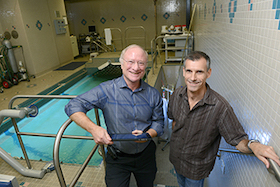
Is it possible to get too much exercise?
That’s one of the current controversies in the field of sports cardiology. Everyone knows exercise is good for the heart and, generally speaking, the more you exercise, the better your heart health.
But there is some disagreement about the extremes of exercise. Could participating in ultramarathons, for instance, cause harm to the heart?
My UT Southwestern colleagues and I, in a joint venture with the Institute for Exercise and Environmental Medicine (IEEM) at Texas Health Presbyterian Hospital Dallas, will be gathering evidence this fall that will help resolve this controversy. We’re virtually monitoring North Texas endurance swimmer Ben Lecomte’s heart as he attempts to become the first person to swim across the Pacific Ocean.
Ben will plunge into the ocean off a Tokyo beach in November heading toward San Francisco. He’ll swim for eight hours each day, using GPS technology to mark the location where he emerges from the water. He’ll sleep on a boat manned by crew members that will accompany him on his journey. The next day, he’ll re-enter the water at the same point he left it. He expects to complete the 5,500-mile effort in five to six months.
What would possess someone to swim across the Pacific Ocean? Passion – that’s what. Here’s Ben’s story in his own words:
What makes Ben swim?
I don’t want to live a routine life. There are people who climb mountains. There are people who sail around the world. Swimming is my passion.
My goal is to bring attention to environmental issues. I’ve noticed changes in the water over my lifetime, more plastic, less and less sea life. It is my duty as a father to try to do anything and everything I can to reduce the liability on the environment that I am going to pass on to my children.
Many people ask if I am worried about running into sharks. The ocean is their place and I hope I do encounter sharks because it will give me an opportunity to talk about what we have done to them. Their numbers are down by 90 percent from what they used to be.
Paying attention to weather and currents will be a key part of my swim. I’ll be swimming at a speed of 2 to 2.5 knots (2 to 2.8 miles per hour) in my wet suit and flippers, but ocean currents can flow at twice that speed, so it will be crucial for me to be swimming with the current.
In some ways, the most challenging part of the swim will be mental. The view from the water never changes and you have to plan ways to occupy your mind. For me, though, the challenge is worth it.
How we’ll monitor Ben’s heart
During the summer of 2015, my colleagues and I gathered baseline data on Ben’s heart. His heart looks fantastic – it’s strong and beats normally. We’ll compare the baseline images to the images we receive digitally throughout the months of Ben’s swim, looking for any changes that might occur.
While Ben’s in the water, NASA sonographer David Martin will use remote guidance echocardiography to regularly monitor Ben’s heart. This the same technology physicians use to monitor the health of astronauts on the International Space Station. David will work from the offices of NASA contractor Wylie Industries in Houston, thousands of miles away from Ben.
GE Healthcare has provided a portable Vivid q device – a sonogram machine no bigger than a laptop – which Ben’s crew members will use under the guidance of our sonographer in Dallas to produce video images of Ben’s beating heart.
My motivation for participating in this research is clear. We want to learn whether endurance exercise – under proper medical supervision – is safe for the heart.
We wish Ben well on this amazing endeavor. It’s clear that the heart we’ll be monitoring is a large one.
Follow us on Facebook and Twitter for updates on Ben’s record-setting journey across the Pacific Ocean.
Still curious? Learn more about this ongoing research endeavor on our website, and this short video that dives deeper into our endurance exercise and NASA Space Station research.











